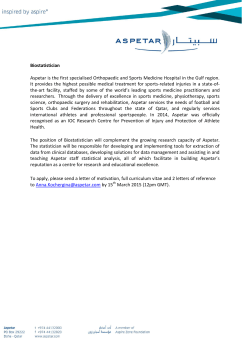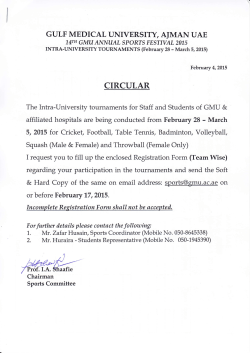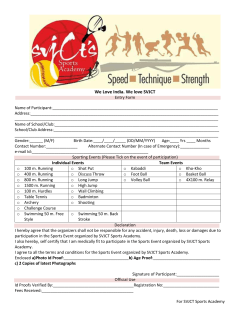
a functional movement screening on 6th grade students of a
International Journal of Physical Education, Fitness and Sports J o ur na l ho mep a ge: www .ij p e fs. n o no l y mp ict i me s .o rg ISSN: 2277: 5447 | Vol.4.No.1 | March’2015 A FUNCTIONAL MOVEMENT SCREENING ON 6TH GRADE STUDENTS OF A CARIBBEAN ELEMENTARY LABORATORY SCHOOL José E. Betancourt, Jean Pierre Betancourt, Luis Estrada, Ismara Ortiz, Desmond Santiago. University of Puerto Rico ABSTRACT: The purpose of this study was to examine the functional body movement of sixthgrade students of a Caribbean Elementary Laboratory School. A total sample of 39 students, including special education, participated in the study. The Functional Movement Screening Test was used to identify the functional movement body profile of the students and the strength and areas to be improved in their body movement after completing a Physical Education Program K6. The participants completed a series of movement exercises (Deep Squat, Hurdle Step, Inline Lunge, Shoulder Mobility, Active Straight-Leg Raise, Trunk Stability Pushup, and Rotary Stability) of seven different skills of the Functional Movement Screening (FMS). An independent t-test analysis and descriptive data was used to analyses the collect data. The findings of the study show that 87.3% students from the Elementary Laboratory School of the University of Puerto Rico scores 14 points or more on the Functional Movement Test. The results of the study reflect that students of laboratory school that experiences different learning practices in Physical Education Program benefits their body functional movement. Keywords: Physical Education; Functional Body Movement; Laboratory School INTRODUCTION According to Erickson, Gray, Wesley, and Dunaga (2012), the continuity experience of the laboratory school from K-12 allows a more comfortable and less stressful environment. The Physical Education (PE) program of this Caribbean Elementary Laboratory School emphasizes this statement. The PE program looks to provide a healthy, active, recreational environment so that students enjoy what they are learning. According to shape America.org, the National Standard 5 of PE establishes that students must recognize the value of physical activity for health, enjoyment, challenge, self-expression, and social interaction. The implementation of different learning strategies, such as an inclusive environment, grouping students, and cooperative learning provides an opportunity to develop students’ better functional body movement. Two example of this approach from different perspective are The Effect of Physical and Music Education in the Development of Motor Skills in Children between Six and Eight Year-Olds in an Inclusive Environment, Betancourt & Hernandez (2012) and The Practice of 1|Page International Journal of Physical Education, Fitness and Sports J o ur na l ho mep a ge: www .ij p e fs. n o no l y mp ict i me s .o rg ISSN: 2277: 5447 | Vol.4.No.1 | March’2015 Olympic Wrestling as a Mechanism of Behavior Modification in Elementary School Special Education Students, Betancourt, De Juan, González & Ortiz (2012). The purpose of this study was to examine the functional body movement of sixth-grade students of a Caribbean Elementary Laboratory School. A total sample of 39 students, including special education, participated in the study. The Functional Movement Screening Test was used to identify the functional movement body profile of the students and the strength and areas to be improved in their body movement after completing a Physical Education Program K-6. The student group completed the appropriate consent and permission forms required to participate in the study. The participants completed a series of movement exercises (Deep Squat, Hurdle Step, Inline Lunge, Shoulder Mobility, Active Straight-Leg Raise, Trunk Stability Pushup, and Rotary Stability) of seven different skills of the Functional Movement Screening (FMS). Functional Movement Screening According to Cook (2006), FMS is a ranking and grading system that documents movement patterns considered vital for normal functioning of the body. This system uses seven predesigned movement tests that combine major and often injured muscle groups; while a screener assigns points (0-3) based on how well the movements were performed. FMS scoring is quantitative, a higher score relates to increased functional movement, and a lower score point identifies dysfunctional body movement along with a prescription for the necessary exercises needed to restore proper movement and build strength for individuals. The purpose of the FMS is to (a) to identify functional limitations and asymmetries, (b) reduce the effects of functional training and physical conditioning and distorted body awareness, and (c) predict future injuries by identifying compensatory movements for any asymmetries, which are risk factors for injuries. Previous Research According to Lisman, O'Connor, Deuster, and Knapik (2013) the FMS can be used to predict future injuries. The researchers recruited 874 Marine Corps officer candidates from 6and 10-week programs. They completed an exercise history questionnaire, underwent an FMS during medical in-processing, and completed the standardized PFT (pull-ups, abdominal crunch, and 3-mile run) within one week of training. Injury data were gathered throughout training from medical records and classified into overuse, traumatic, and any injury. While they found a slow three mile run time (RT) to be the only component to be predictive of injury; if you combined slow RTs with low FMS scores (≤14) the injury predictive value was found to increase significantly. Therefore, while not singularly predictive for injury in this service member population, the FMS did increase the injury predictive value when combined with a predictable exercise this group would engage in, in this case a three mile run. While testing the same concept as Lisman (3), Letafatkar, Hadadnezhad, Shojaedin, and Mohamadi (2014), conducted a cross-sectional study to research whether a combination of FMS 2|Page International Journal of Physical Education, Fitness and Sports J o ur na l ho mep a ge: www .ij p e fs. n o no l y mp ict i me s .o rg ISSN: 2277: 5447 | Vol.4.No.1 | March’2015 scores and history of injury could be used to determine which subjects were prone to injury. They evaluated 100 physically active students (50 male and 50 female), between the ages of 18 and 25, using the FMS criteria and conducted a chi-square, independent t-test, one-way analysis of variance, and post hoc Bonferroni tests. They were able to calculate an odds ratio of 4.70, meaning that an athlete had an approximately 4.7 times greater chance of suffering a lower extremity injury during a regular competitive season if they scored less than 17 on the FMS. Furthermore, they found statistical differences in the pre-season FMS scores between the injured and non-injured groups. Although they cautioned the need for more researched; the researchers praised the low cost and simplicity of the FMS criteria and suggested their research established reference values that could be used to evaluate athletes in the future. Therefore, unlike Lisman (3), this study found FMS scores could relate directly to injury prediction and an almost five times higher risk of injury for young adults showing asymmetries. The major factor for success in subject evaluation using FMS is confidence in the results. Since FMS evaluation requires a certified screener to objectively evaluate movements, large groups of subjects would require more than one screener. Given this limitation, screening results between trainers must be reliable. Teyhen et al.2012 attempted to test the intra-rater test-retest and inter-rater reliability of the FMS among novice raters. They recruited 64 active-duty service members and assessed intra-rater test-retest reliability between baseline scores and those obtained with repeated testing performed 48 to 72 hours later. Inter-rater reliability was based on assessments by two raters, selected from a pool of eight novice raters, who assessed the same movements on day two simultaneously. They then calculated descriptive statistics, weighted kappa (κw), and percent agreement on component scores with 95% confidence intervals (CIs). Their results showed moderate to good inter-rater and intra-rater reliability, with acceptable levels of measurement error among the novice scorers. These results suggested that while experienced scorers are preferable, new screeners may be trusted and utilized in evaluating subjects. In addition, Kraus, Schütz, Taylor, and Doyscher (2014) found experience to be a preferred factor. They collected 34 FMS papers from computer databases to evaluate the efficacy of the FMS. Their results showed that the FMS is a reliable screen, but recommended scorers have greater than 100 trials under their belt. Furthermore, they found that studies clearly illustrate the FMS’s limited ability to predict athletic performance and that the FMS total score’s ability to evaluate injury risk in team sports is supported by moderate scientific evidence. Finally, the majority of the FMS-based intervention programs showed improvement in general motor quality; however, a randomized trial did not confirm those results. This data clearly shows that although experience is preferred, as in any endeavor, exercise programs, research teams or whoever else requires more than 1 certified FMS evaluator can be confident in reliability of each scorer’s results. 3|Page International Journal of Physical Education, Fitness and Sports J o ur na l ho mep a ge: www .ij p e fs. n o no l y mp ict i me s .o rg ISSN: 2277: 5447 | Vol.4.No.1 | March’2015 A major weakness in current FMS research is the lack of knowledge in FMS usefulness at the pediatric level. The pediatric population is known as an active population, and many asymmetries that develop later on in life could be due to injuries sustained at an earlier age. Since pediatric conditioning, whether for a typical PE class or youth-level sports, do not routinely incorporate movement evaluation, the FMS could be used to identify early compensation that can lead to injury later on in life. Duncan and Stanley (2012) wanted to investigate the existence of any relationship between BMI, ambulatory physical activity, and FMS performance in a pediatric population comprised of 58, 10- to 11-year-old British children. They found total FMS score was significantly, negatively correlated with BMI and positively related to physical activity. Furthermore, their results highlighted physical activity and weight status as significant predictors of functional movement in British children. The authors recommended future interventions to develop functional movement skills alongside physical activity and weight management strategies in children to reduce the risks of orthopedic abnormalities arising from suboptimal movement patterns in later life. These findings led us to believe that early implementation of movement evaluation at the youth sports level could help mitigate injury risk as well as create more well-balanced athletes since all sports require body control/balance for optimum results. Although more research needs to be conducted to coalesce conflicting results, the FMS shows great promise in its ability to predict injury by identifying compensatory movements brought about by asymmetric ability in the body. Specifically, the use of reference values is an area that needs more research since some research projects use different cutoff scores for injury prediction, with two of the ones cited using 14 and 17. Finally, because of the low cost of implementation of the FMS system; its room for customization whether for a specific sport, population, or subject; the higher prediction value obtained when combined with other judging parameters; and the ability to be implemented across populations, the FMS shines with great promise. RESEARCH QUESTIONS 1. What is the functional movement profile of sixth-grade students of a Caribbean Elementary Laboratory? 2. Is there a significant statistical difference between the final FMS score obtained by girls as opposed to boys? 3. Is there a significant statistical difference between the final FMS scores obtained between the participants that participate in sports and those who do not? 4. What is the skill that requires the most attention in this student group? 4|Page International Journal of Physical Education, Fitness and Sports J o ur na l ho mep a ge: www .ij p e fs. n o no l y mp ict i me s .o rg ISSN: 2277: 5447 | Vol.4.No.1 | March’2015 METHODS This research compiled quantitative data using descriptive statistics such as percentages, frequencies, standard means, and standard deviations. Furthermore, to look for information to answer the research questions a t-test was administered to independent groups, with two tails and an α = .05. PARTICIPANTS A total sample of 39 sixth-grade students participated in this investigation during Spring 2014. Their ages were either 11 (17/39, 43.6%) or 12 (22/39, 56.4%). Of the total, 53.8% were females (21/39) and 46.2% were male (18/39); furthermore, a total of 23 (59.0%) actively practice some sport. Female students had the lower sports participation rate (11/39, 25.6%) of either gender. Thirteen of the eighteen males participated in sports (72.2%); furthermore, ten of the twenty-one females (47.6%) participated in sports as well (See Graphs 1, 2, 3, Table 1, 2A and 2B). 5|Page International Journal of Physical Education, Fitness and Sports J o ur na l ho mep a ge: www .ij p e fs. n o no l y mp ict i me s .o rg ISSN: 2277: 5447 | Vol.4.No.1 | March’2015 6|Page International Journal of Physical Education, Fitness and Sports J o ur na l ho mep a ge: www .ij p e fs. n o no l y mp ict i me s .o rg ISSN: 2277: 5447 | Vol.4.No.1 | March’2015 Age 11 12 Total Program Regular Special Education Table 1: Students profile by age and gender. Gender F M 10 7 25.6% 17.9% 11 11 28.2% 28.2% 21 18 53.8% 46.2% Total 17 43.6 % 22 56.4% 39 100.0% Table 2. Students profile by program. Frequency and percentage 30 (76.9%) 9 (23.1%) 7|Page International Journal of Physical Education, Fitness and Sports J o ur na l ho mep a ge: www .ij p e fs. n o no l y mp ict i me s .o rg ISSN: 2277: 5447 | Vol.4.No.1 | March’2015 Table 3. Students profile by gender and primary sports Sport Gender Total F M None 11 5 16 25.6% 12.8% 41.0% Track and Field 1 0 1 2.6% 00.0% 2.6% Volleyball 3 0 3 7.7% 00.0% 7.7% Rhythmic Gymnastics 1 0 1 2.6% 00.0% 2.6% Soccer and Basketball 1 0 1 2.6% 00.0% 2.6% Roller skating 1 0 1 2.6% 00.0% 2.6% Capoeira 1 0 1 2.6% 00.0% 2.6% Soccer 1 5 6 2.6% 12.8% 15.4% Dancing 1 0 1 2.6% 00.0% 2.6% Basketball 0 4 4 00.0% 10.3% 10.3% Football 0 2 2 00.0% 5.1% 5.1% Baseball 0 1 1 00.0% 2.6% 2.6% Tennis 0 1 1 00.0% 2.6% 2.6% Total 21 18 39 53.8% 46.2% 100.0% Table 4. Students profile by gender and those that do or not sports. Sport Gender Practice or not sport F M Total 8|Page International Journal of Physical Education, Fitness and Sports J o ur na l ho mep a ge: www .ij p e fs. n o no l y mp ict i me s .o rg ISSN: 2277: 5447 | Vol.4.No.1 | March’2015 Don’t Practice Practice Total 11 52.4% 10 47.6% 21 53.8% 5 27.8% 13 72.2% 18 46.2% 16 41.0% 23 59.0% 39 100.0% DISCUSSION AND FINDINGS Most of the students obtained 2 points in the Deep Squat with (38.5%) for girls and (20.5%) for boys. The Hurdle Step test showed similar results on both genders with (33.3%) for girls and (38.5%) boys scoring 2 points. For the Incline Lunge test, 35.9% of girls received a final score of 3; compared with 20.5% of boys who scored a 2 during the same evaluation. During the Shoulder Mobility test, most of the participants received a final score of 3. For the Active Straight- Leg Raise Test, 33.3% of the girls received a final score of 3 compared with 25.6% of the boys who only received 2 points. Interestingly, 7 of the 18 male students had a greater score (2 out of 3) than their female counterparts during Trunk Stability, with 12 of the 21 females obtaining a score of 1 in this category. Finally, the majority of both males and females obtained a final score of 2 for the Rotary Stability evaluation (See Table and Graph 5). The total scoring of both genders reflected high percentages in the ideal score of 14 or greater (See Table 4). Girls received a higher percentage of 14 or greater scores (48.7%), compared to boys (38.5%). The Girls scores showed a mean of 16.10 with a standard deviation of 2.30, compared to boys who showed a mean of 15.20, with a standard deviation of 2.60. The independent t-test was performed with an α = .05. This analysis resulted in a probability of p = .22. Since p > .05 the measured difference between groups of 0.90 in the mean was not statistically significant between males and females (See Table 7). Test Deep Squat Hurdle Step Incline Lunge Table 5. Final score by gender ((N/39) x 100) Final Score 3 2 1 F M F M F M 5 6 15 8 1 4 12.8% 15.4% 38.5% 20.5% 2.6% 10.3% 8 2 13 15 0 1 20.5% 5.1% 33.3% 38.5% 00.0% 2.6% 14 7 7 8 0 3 35.9% 17.9% 17.9% 20.5% 00.0% 7.7% 0 F 0 00.0% 0 00.0% 0 00.0% M 0 00.0% 0 00.0% 0 00.0% 9|Page International Journal of Physical Education, Fitness and Sports J o ur na l ho mep a ge: www .ij p e fs. n o no l y mp ict i me s .o rg ISSN: 2277: 5447 | Vol.4.No.1 | March’2015 Shoulder Mobility 18 46.2% Active Straight- 13 Leg Raise 33.3% Trunk Stability 5 12.8% Rotary Stability 1 2.6% Total Score Less than 14 14 or more Total 17 43.6% 8 20.5% 5 12.8% 0 00.0% 3 7.7% 8 20.5% 3 7.7% 15 38.5% 1 2.6% 10 25.6% 7 17.9% 14 35.9% 0 00.0% 0 00.0% 12 30.8% 5 12.8% 0 00.0% 0 00.0% 5 12.8% 4 10.3% Table 6. Total score by gender ((N/39) x 100) Gender F M 2 3 5.1% 7.7% 19 15 48.7% 38.5% 21 18 53.8% 46.2% 0 00.0% 0 00.0% 1 2.6% 0 00.0% 0 00.0% 0 00.0% 1 2.6% 0 00.0% Total 5 12.8% 34 87.2% 39 100.0% 10 | P a g e International Journal of Physical Education, Fitness and Sports J o ur na l ho mep a ge: www .ij p e fs. n o no l y mp ict i me s .o rg ISSN: 2277: 5447 | Vol.4.No.1 | March’2015 Graphic 6: Final score by gender Table 7. Final score’s average, standard deviation, and t-test by gender Statistics F M Comparison between F and M Average 16.10 15.20 0.90 Standard Deviation 2.30 2.60 0.30 The total score of FMS showed a higher percentage of scores 14 or greater in students who practiced some sports (53.8%) as compared with those who did not. The results showed a mean of 16.0 with standard deviation of 2.60. For active students in sports compared to a mean of 15.30 and a standard deviation of 2.20 for those who do not practice any sport. The independent t-test analysis with an α = .05 showed a probability of p = .43. This result indicates the difference of 0.90 in the means between groups of students with and without sports participation was not statistically significant (See Table 9). 11 | P a g e International Journal of Physical Education, Fitness and Sports J o ur na l ho mep a ge: www .ij p e fs. n o no l y mp ict i me s .o rg ISSN: 2277: 5447 | Vol.4.No.1 | March’2015 Table 8. Total score by sport that they practice or not ((N/39) x 100) Sport Total Score Total 14 or more Less than 14 Practice sport 21 2 23 53.8% 5.1% 59.0% Don’t practice sport 13 3 16 33.3% 7.7% 41.0% Total 34 5 39 87.2% 12.8% 100.0% Table 9. Final score’s average, standard deviation, and t-test by sports practice or not Statistics Practice sports Don’t practice sports Comparison between those that practice or not sports Average 16.00 15.30 0.70 Standard Deviation 2.60 2.20 0.40 The total score of both educational programs resulted in a high percentage of scores of 14 or greater (See Table 10). Twenty-six out of thirty of the participants from the Regular Education program scored 14 or greater. Furthermore, eight out of nine of the students in the Special Needs program scored 14 or greater (See Table 10). The means for the Regular 12 | P a g e International Journal of Physical Education, Fitness and Sports J o ur na l ho mep a ge: www .ij p e fs. n o no l y mp ict i me s .o rg ISSN: 2277: 5447 | Vol.4.No.1 | March’2015 Education and Special Education groups were 15.60 and 16.00 respectively, with a standard deviation of 2.50 for both groups. To determine whether the difference in means was statistically significant an in independent t-test was performed with an α = .05. The results showed a probability of p = 0.68. Given that p > .05, this indicates that the difference between the means of 0.40 was not statistically significant (See Table 11). Program Regular Special Education Total Table 10. Total score by program ((N/39) x 100) Total Score Total 14 or more Less than 14 26 4 30 66.7% 10.2% 76.9% 8 1 9 20.5% 2.6% 23.1% 34 5 39 87.2% 12.8% 100.0% Table 11. Final score’s average, standard deviation al t test by program Statistics Regular Special Education Comparison between those that belongs to Regular or Special Education Program Average 15.60 16.00 0.40 Standard Deviation 2.50 2.50 0.00 Furthermore, a larger portion of females (12/39, 30.8%) demonstrated a greater need for treatment in Trunk Stability as opposed to males, although five males also reflected inadequacies during their evaluations. Upon observing the totality of content in Table 12, males and females demonstrated almost similar necessities (5/39, 12.8% of males and 12/39, 30.8% of females) for treatment (See Table 12). Sport Skill Deep Squat Table 12. Final Scores- Need of Treatment ((N/39) x 100) Gender 2 1 F M F M 1 0 0 0 2.6% 00.0% 00.0% 00.0% Total 1 2.6% 13 | P a g e International Journal of Physical Education, Fitness and Sports J o ur na l ho mep a ge: www .ij p e fs. n o no l y mp ict i me s .o rg ISSN: 2277: 5447 | Vol.4.No.1 | March’2015 Hurdle Step 1 2.6% Incline Lunge 0 00.0% Shoulder Mobility 0 00.0% Active Straight- Leg 2 Raise 5.1% Trunk Stability 1 2.6% Rotary Stability 4 10.3% Total 9 23.1% 3 7.7% 1 2.6% 0 00.0% 3 7.7% 1 2.6% 2 5.1% 10 25.6% 0 00.0% 0 00.0% 0 00.0% 0 00.0% 12 30.8% 0 00.0% 12 30.8% 0 00.0% 2 5.1% 0 00.0% 0 00.0% 5 12.8% 1 2.6% 8 20.5% 4 10.3% 3 7.7% 0 00.0% 5 12.8% 19 48.7% 7 17.9% 29 74.4% CONCLUSIONS 1. Laboratory School PE Program that utilizes an inclusive environment promotes active participation, develops different learning strategies that benefit students on their functional movement. 2. Girls that practice some sports demonstrate better functional movement than boys who practice some sports. 3. Practice sports as an extracurricular activity combined with a PE program help students to improve the functional movement of the body. 4. The independent t-test analysis applied with the purpose of answering questions 2, 3, and 4 reflected no statistically significant differences between the means of the different groups. 5. The PE program must focus on developing activities or sports that improve Trunk Stability skills. 14 | P a g e International Journal of Physical Education, Fitness and Sports J o ur na l ho mep a ge: www .ij p e fs. n o no l y mp ict i me s .o rg ISSN: 2277: 5447 | Vol.4.No.1 | March’2015 REFERENCES [1] Betancourt, J.E., & Hernandez, M. (2012). The Effect of Physical and Music Education in the Development of Motor Skills in Children between Six and Eight Year-Olds in an Inclusive Environment. NALS Journal, Vol.1, Iss.1, Article 1. [2] Betancourt, J.E., De Juan, B., Gonzalez, M., & Ortiz, I. (2012). The Practice of Olympic Wrestling as a Mechanism of Behavior Modification in Elementary School Special Education Students, NALS Journal: Vol. 3: Iss. 1, Article 3. a. Retrieved from http://digitalcommons.ric.edu/nals/vol3/iss1/3 [3] Cook, G., Burton, L., & Hogneboom, B. (2006). Pre-participation screening. The use of fundamental movements as an assessment of function-Part 2. North American Journal of Sports Physical Therapy, 1, 132-139. a. Retrieved from http://www.ncbi.nlm.nih.gov/pmc/articles/PMC2953313/ [4] Duncan, M. J., & Stanley, M. J. (2012). Functional movement is negatively associated with weight status and positively associated with physical activity in British primary school children. Journal of Obesity, 2012(697563). http://dx.doi.org/10.1155/2012/697563 [5] Erickson, P.; Gray, N.; Wesley, B.; & Dunagan, E. (2012). Why parents choose laboratory schools for their children. NALS Journal, 2(2), 2. Retrieved from http://digitalcommons.ric.edu/cgi/viewcontent.cgi?article=1010&context=nals [6] Kazman, J. B., Galecki, J. M., Lisman, P., Deuster, P. A., OʼConnor, F. G. (2014). Factor structure of the functional movement screen in marine officer candidates. Jounral of Strength and Conditioning Research, 28, 672-678. http://dx.doi.org/10.1519/jsc.0b013e3182a6dd83 [7] Kraus, K., Schütz, E., Taylor, W. R., & Doyscher, R. (2014). Efficacy of the functional movement screen: A review. Journal of Strength and Conditioning Research. Advance online publication. http://dx.doi.org/10.1519/jsc.0000000000000556 [8] Letafatkar, A., Hadadnezhad, M., Shojaedin, S., & Mohamadi, E. (2014).Relationship between functional movement screening score and history of injury. International Journal of Sports Physical Therapy, 9, 21-27. Retrieved from http://www.ncbi.nlm.nih.gov/pmc/articles/PMC3924605/ [9] Lisman, P., O’Connor, F. G., Deuster, P. A., & Knapik, J. J. (2013). Functional movement screen and aerobic fitness predict injuries in military training. Medicine and Science in Sports and Exercise; 45, 636-643. http://dx.doi.org/10.1249/MSS.0b013e31827a1c4c 15 | P a g e International Journal of Physical Education, Fitness and Sports J o ur na l ho mep a ge: www .ij p e fs. n o no l y mp ict i me s .o rg ISSN: 2277: 5447 | Vol.4.No.1 | March’2015 [10] Teyhen, D. S., Shaffer, S. W., Lorenson, C. L., Halfpap, J. P., Donofry, D. F., Walker, M. J., . . . Childs, J. D. (2012). The functional movement screen: A reliability study. The Journal of Orthopaedic and Sprots Physical Therapy, 42, 530-40. http://dx.doi.org/10.2519/jospt.2012.3838 ***** 16 | P a g e
© Copyright 2025









